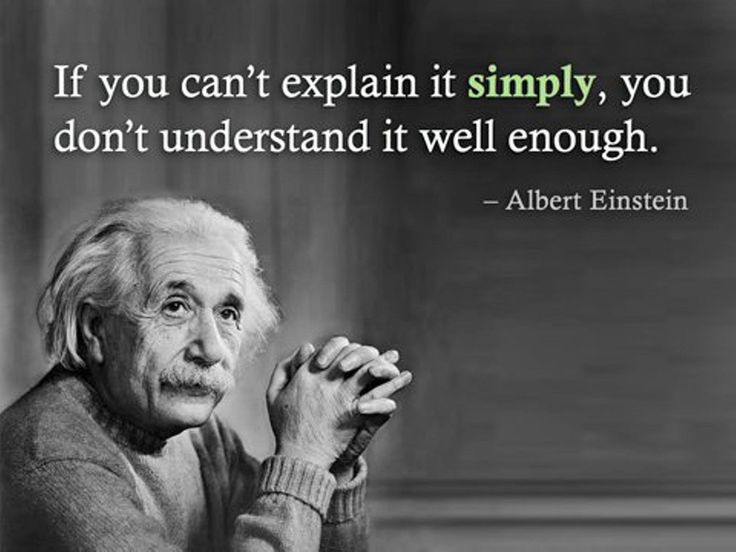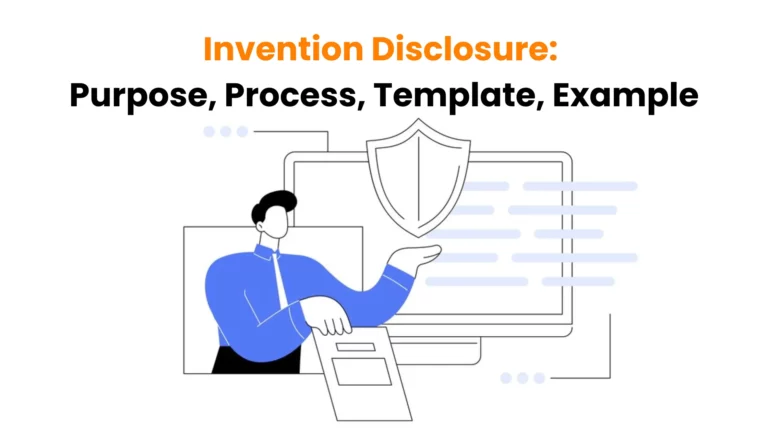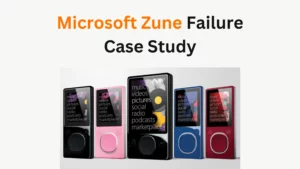Understanding what is invention disclosure is the fundamental requirement, but understanding the purpose of invention disclosure is what helps us disclose efficiently.
An invention disclosure is indeed the first notification of your invention to your peers, leaders, organization, and the world, so it needs to be flawless.
But it’s you who benefits the most from drafting a thorough invention disclosure form!
Download free invention disclosure template.
Arranges your thoughts, brings your invention together
Before we explain the purpose and process of the invention disclosure form, let’s recall what Albert Einstein said for a moment.
“If you can’t explain it simply, you don’t understand it well enough.”

The basic expectation from a good disclosure form is that it showcases every detail, nuance, “Eureka!” moment, and chronology of an invention in a simple and understandable manner.
An inventor has to present their brainchild to an uninitiated person and impress them with its simplicity and capability.
Easier said than done! Inventors fail to argue their case and their patent claim suffers.
Instead of cutting their patent application time to 6-8 weeks, they end up stretching it up to months or even an entire year.
This is why a good invention disclosure template enables an inventor to arrange their thoughts and bring out the best in their invention.
It ALWAYS helps them to refine their invention.
When they are filling out an invention disclosure, they are able to:
- Compose their thoughts and understand their brainchild
- Find the best aspects of their invention
- Identify the patentability of their idea
- Create a gist of their invention
- Conduct a prior art search
- Differentiate how their invention is better or unique from an available art
- Improve the foggy bits of their design
- Reiterate the reproduction of their invention
- Lay out both positive and negative facts about the invention for informed decision making
- Maintain an iron-clad document, protecting their intellectual property
It’s not just about dumping ideas onto paper; it’s about organizing chaos into clarity.
Bring investors and patent attorneys on board with your invention
Imagine you’re pitching a movie idea to a producer. You wouldn’t just ramble about random scenes; you’d lay out the plot, characters, and twists in a clear, compelling way.
You will need to convince them that the story will be a success and garner many distributors.
Invention disclosure does the same thing but for your invention.
A. Patent Attorney
It helps patent attorneys understand the inventor’s vision and use the record of invention disclosure as a basis for drafting the patent application.
It expedites the drafting process greatly and patent attorneys are able to communicate the real value of inventions through patent drafts.
Actually, the entire patent prosecution process becomes collaborative and productive, establishing a positive relation between the inventor and the IP department.
B. Investors
Investors want to see potential, but they also want to see clarity and strategy.
A well-crafted invention disclosure does not just show a cool idea; it shows inventors a roadmap to success. It’s important they can analyze the monetary value of the invention and its commercialization potential in the market.
C. Third-Party
Almost always, after you’ve had the idea, you need a team of experts to develop it and turn it into something patent-worthy. Invention disclosure documentation comes in handy!
For instance, it comes to the inventor’s aid when they are looking to develop a prototype with the help of the engineers and designers team. They use the draft to help accountants and finance departments understand the budget requirements for invention’s design.
Defend your intellectual property claims
Invention disclosure is like waving a “Keep Out” flag around your intellectual property (IP).
A disclosure can help you defeat legal challenges to your patent.
Also known as a record of invention (ROI), invention disclosure acts as a confidential document written by the inventor.
By clearly outlining the invention—how it works, what makes it unique, and why it’s valuable—the disclosure creates a strong defense against anyone who tries to copy or dispute the inventor’s IP rights.
When you file a patent or apply for other forms of IP protection, having a solid invention disclosure can be your best ally. It’s like presenting a meticulously crafted case to a judge. You’re not just saying, “Hey, this is my idea!” You’re laying out the evidence in a way that’s hard to refute.
Plus, having a detailed invention disclosure can deter potential infringers. When they see how well-documented your invention is, they’ll think twice before trying to challenge your IP rights. It’s like having a guard dog patrolling your property—you might not need to use it, but just knowing it’s there can keep troublemakers at bay.
Related Read: Don’t Miss these Intellectual Property Management Tips to Build a Strong IP Portfolio
Ensure stakeholders give due attention to your invention
When inventors document their invention thoroughly and clearly, they essentially roll out the red carpet for stakeholders.
They’re saying, “Hey, check out this amazing thing I’ve created!”
But it’s not just about getting their attention, inventors assure that their inventions are being taken seriously and evaluated.
When IP departments, leaders, and managers are held accountable by creating a trail of evidence that ideas and inventions need their attention and action, inventors win.
Upon submission, the Invention Disclosure Form initiates action by people responsible for each phase; evaluators, internal attorneys, external attorneys, and co-innovators.
And here’s the kicker: when stakeholders see how well-documented your invention is, it signals that you’re serious about it. It shows that you’ve put in the time and effort to flesh out your idea and make it a reality. That kind of dedication commands respect and attention.
Make collaboration easy
Invention disclosure acts like a shared blueprint for your invention, bringing everyone onto the same page and making collaboration a breeze.
Data shows that mostly inventions have more than one innovator listed as the inventors.
So, with everything at one place in an editable format, innovators can communicate and collaborate on their shared invention ideas.
Co-innovators can provide their due diligence, due thoughts, ideas, and contribution. Mutual trust and coordination prospers!
Related Read: Don’t Buy Invention Disclosure Software Until Your Review This!
How do you write an invention disclosure?
An IDR or IDF needs to be brief but provide every bit of essential information possible. So, when you know the answer to what is the full disclosure of the invention, you’ll be off to disclosing your invention.
Download a ready-made invention disclosure template free of charge.
#1 Basic Inventor Information
Get the most basic information out of the way.
- Full Name of the Inventor
- Full Name of the Co-Inventor(s)
- Contact Information
- Affiliation/Company
- Date of Invention
#2 Title of the Invention
Begin with a concise title that encapsulates the essence of your invention without giving away any confidential information.
Ensure the subject of the invention is clear through the title and falls between 15-20 words.
#3 Summary of the invention
Offer a high-level overview of your invention, outlining its core components, pioneering features, functionalities, and intended applications. Emphasize the technical innovations or advancements that distinguish your invention from existing solutions.
You can also include the benefits of the invention to clearly state the areas of industrial application and commercialization.
#4 Voice of the Inventor
Provide a primary use case and your vision for the invention in one to two sentences.
#5 Describe the invention in detail
Provide a comprehensive description of your invention, covering its design, operation, and functionality in intricate detail. Use technical language and terminology relevant to your field to ensure precision and clarity.
You must provide keywords related to your invention to help patent attorneys classify the invention correctly while drafting your patent.
Focus on answering the following questions as well:
- What problem does this invention solve?
- Why is this invention better than the existing inventions?
- Why did no one else think of this invention according to you?
Note: Provide ample (if relevant) designs and diagrams. If you are referring to terms from different languages, ensure that you have provided English equivalents to them in your description.
#6 Co-Inventor and Third-Party Contributors
Mention every individual who may have conceived or developed the elements in your invention jointly with you.
The details must include, but not limited to the following:
- Name
- Gender
- Title/Role
- Phone Number
- Company
- Association
- Citizenship
- Contribution Percentage
#7 Circumstances leading to the idea for the invention
What made you think of this idea and develop it into an invention?
#8 Current Stage
What is the latest development stage of the invention?
- Still an idea / concept
- Very early stage
- Ready with proof of concept
- Ready with a prototype
- Mention any other ________
#9 Competitive advantage of your invention
What more we are getting from your innovation? What are the benefits of your invention over the competitor approaches?
#10 Supporting Evidence and References
Cite relevant literature, prior art, or supporting evidence to substantiate the novelty, inventive step, and technical merit of your invention. Provide references to authoritative sources, scientific publications, or patent documents that corroborate your claims and provide context.
If the invention improves upon an existing product, describe the existing invention and the distinguishing quality to the prior art.
#11 Technical Drawings and Diagrams
Supplement your description with detailed technical drawings, schematics, or diagrams illustrating the structure, configuration, and operation of your invention. These visual aids enhance understanding and facilitate further analysis.
Basically, attach all supporting materials, such as technical specifications, sketches, presentations, CAD, notebook pages, test data, photographs, and so on.
#12 Publication Dates
Provide the date and location of your first sketch or drawing of the invention. Also, include the date you first conceived the idea for invention.
#13 Declaration and Submission
I have discussed the content of this invention disclosure and obtained consent for its submission with all the inventors.
All contributors and stakeholders must review and sign the Declaration.
List any agreement, such as consulting, assignments, licensing, material transfer, etc., that would affect ownership, rights, and/or interests in the invention.
If necessary, include provisions for confidentiality and non-disclosure to protect sensitive information disclosed in the invention disclosure. Specify the intended recipients and conditions governing the disclosure and use of confidential information.
#14 Signatures
All inventors and contributors must sign the form.
Invention Disclosure Example
Here’s an example of a filled invention disclosure form template.
Download IDF for free now.
Bonus Tip
Although a template is a good starting point, you cannot disclose inventions using legacy methods forever.
The sooner you get on board with advanced digital software, the better your innovation portfolio and health will be.
The high number of invention disclosures is proof that your organization is nurturing a healthy innovation culture.
Here’s a professional invention disclosure software to get you started instantly – IP Assist



